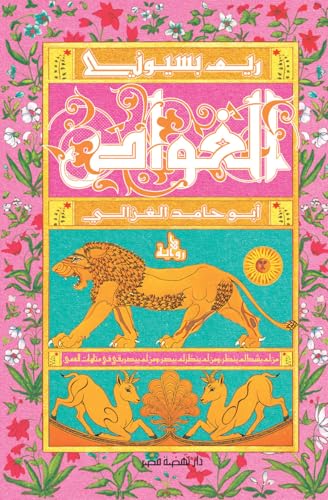The acclaimed Egyptian novelist and linguist Dr. Reem Bassiouney, mostly known for her historical serial novels, in particular her trilogy of the Mamluk era, has recently issued her new novel El-Gwas, The Diver, an account of the life of Abu Hamid Al-Ghazali, the prominent Persian Islamic scholar Sufi figure, jurist and controversial theologian. In this monumental work, she successfully employed the historical elements with fictional ones. Surprisingly, the massive information and data being used reflect the core of Al-Ghazali’s biography from a critical perspective—nonetheless, the fictional character (Al-Ghazali) has been subjected endlessly to scholarly and theological research. One might claim that it’s the first time an influential historical Islamic person has been narratively portrayed and reinterpreted.
What made Al-Ghazali’s biography an attractive one was not only the scholarly role he’d played ten centuries ago, but also his polemic and personal attributes combined with a unique spiritual experiment. From traditional scholar to Sufi, and from philosopher to bewildered person engulfed by the ontological argumentative dilemma. the events-based history and image-oriented narrative prose are intensified by this unique character’s images and actions. And through various narrative upheavals, the character’s position is scrupulously demarcated.
Dr. Bassiouney has managed to trace such a fluctuated personality under the light of historical authentication enriched by her imaginative envisage. To do this, the huge novel, throughout the twenty-one chapters, depicts a novelistic scope in accordance to the progression of the events among various stages of story developments. It is not only a
novel of abstract historical information; rather, it is a humanistic analysis as well as a cultivation in the controversial Islamic theology that was embedded in the persona of
Al-Ghazali, which in turn represents the deepest invisible dynamics powers that formed and directly affected his entire life. Such an invention couldn’t have been done
narratively without mastering the technical skills that a novelist should possess.
Most interesting is the presentation of Al-Ghazali when the novel starts, with a brillaint young orphan man who sought a journey for science, leaving his birth town
to make his way to Baghdad. An unexpected event occurred which would later change his life forever. A group of gang thieves intercrossed his way, his
own life was endangered, but he bravely confronted the situation. He kept his text-books in a bag which was snatched by the thieves, but he insisted they return it.
When he engaged in a lengthy dialogue with them, the thief asked him, “if you wanted to use them, why don’t you keep your science in papers!” A flash sparked in his
mind that would convince him to commit knowledge to memory instead of to papers.
Al-Ghazali’s turbulent life as the novel suggested it had been wonderfully grown despite the fact that it was an achievable one in terms of thought and theologian
scope. It also collided with different scholars of the times because of envy, jealousy and other human darked tendencies and biases. The great scholar narratively as the
protagonist placed within the context of those odd circumstances which are not invented by the novelist rather from Al-Ghazali’s life. The novelist benefited directly
from the documented historic achievements and the Islamic scholar’s legacy to weave such a curious historical fiction. Her experienced, powerful writing skills allowed her to carefully track Al-Ghazali’s real life as he lived along with other related characters, both key and marginal ones.
A historical novel, defined as The Diver has defined it, is an amalgamation of conflicting elements in terms of critical perspectives. In writing about a historical personality, there was much to be meticulously observed and considered. Al-Ghazali’s personal life is not free as expected, like any other human being irresistible to
the natural call. The woman was presented in different kinds of sort: wife, lover and how he responded to this unavoidable fact of life. The novel focused mainly on human deeply thinking and ontological unanswered questions, as well as exploring the deepest darkness within human nature. Such stances were plausibly generated from the escalating events in the novel. Al-Ghazali’s contemplations had guided him to abandon his position as teaching theologian who was surrounded by lots of students and public fans in Baghdad. For a decade he was in a chosen solitude during which he concluded his Sufi orientations.
Seemingly, the novel relates the contemporary evolutions of events and the protagonist who particularly contributed in forming them. The position of the main character has been controversial critically and theoretically altogether. On the contrary, any fictional work has its thematic point (plot) through which characters’ roles should appear cohesively to articulate the entire events whatever their role might be. For example, here we have many characters engaging in events, regardless of the time span which they occupied, but their place is logically understood. That’s why the novel has produced its personality while offering gripping analytical prose, inextricably in addition to the other principles of characterization.
Despite the fact that the similarities of historical and fictional characteristics are remarkable, the novel has profoundly interpreted other fictional elements. This can easily be discovered through the vast historical and intellectual era the novel has conquered to deal with transhistorical concepts. Not like too many other historical novels, The Diver has an open ending that examines the connecting links between its characters and their unavoidable uncertain destinies, if not of course inexplicable. The narrative prose tangibly expressed in detail what can be thought as unspeakable, since the historical events are so sensitive due to symbolizing religious, sectarian and beliefs. Since the novelist technically mastered her own narrative vision, she has paved the way to separate curiously between historical facts, religious and social flaws of that time. And, the historical novel has nothing to do to convey the facts as such, without having energized them fictionally.
Eventually, Dr. Bassiouney proved to be capable of deciphering the strangeness of the past as a novelist and historian. She’d read and interpreted Al-Ghazali’s monumental works to formulate a new perspective from which a reader, researcher, and interested intellectuals could rethink about a great thinker whose life has been thrilled within a novelistic visionary understanding. That’s why one might encounter vivid characters who are not possibly unfamiliar to us.
Dr. Bassiouney also has provided us with a rich historical account which is hardly to be categorized as mere historical research on Islamic history and its active players. In contrast, she wisely guided us to visit the fictional past.


About the Author: Nassir al-Sayeid al-Nour is a Sudanese critic, translator and author.


A very true reading of a unique writer of our culture. Dr. Reem Bassiouny is a genius illustrative composer and producer of a combination of a literay historical and sutble spiritual needed alignment for her reader.